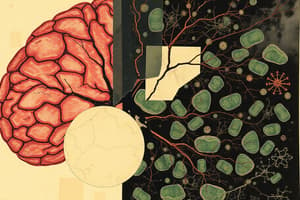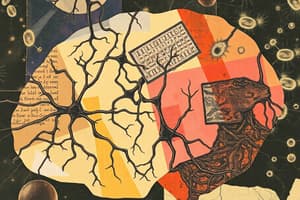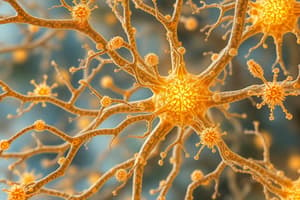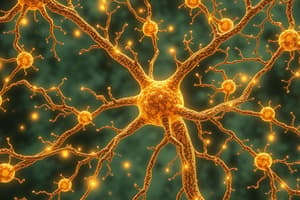Podcast
Questions and Answers
¿Cuál es la función principal del tejido nervioso?
¿Cuál es la función principal del tejido nervioso?
Coordinar y controlar las actividades del cuerpo.
¿Cuáles son los dos tipos principales de células que componen el tejido nervioso?
¿Cuáles son los dos tipos principales de células que componen el tejido nervioso?
- Neuronas y células gliales (correct)
- Células óseas y células cartilaginosas
- Células musculares y células sanguíneas
- Células epiteliales y células conectivas
Las neuronas solo se encuentran en el sistema nervioso central (SNC).
Las neuronas solo se encuentran en el sistema nervioso central (SNC).
False (B)
Las __________ son las unidades fundamentales del sistema nervioso.
Las __________ son las unidades fundamentales del sistema nervioso.
¿Cuáles son los tres componentes principales de una neurona?
¿Cuáles son los tres componentes principales de una neurona?
¿Cuál es la función de las dendritas?
¿Cuál es la función de las dendritas?
¿Cuál es la función del axón?
¿Cuál es la función del axón?
La vaina de mielina disminuye la velocidad de transmisión del impulso nervioso.
La vaina de mielina disminuye la velocidad de transmisión del impulso nervioso.
¿Qué son los nodos de Ranvier?
¿Qué son los nodos de Ranvier?
¿Cómo transmiten información las neuronas?
¿Cómo transmiten información las neuronas?
¿Qué es un potencial de acción?
¿Qué es un potencial de acción?
¿Qué son los neurotransmisores?
¿Qué son los neurotransmisores?
¿Cuáles son los tres tipos principales de neuronas?
¿Cuáles son los tres tipos principales de neuronas?
¿Cuál es la función de las neuronas sensoriales?
¿Cuál es la función de las neuronas sensoriales?
¿Cuál es la función de las neuronas motoras?
¿Cuál es la función de las neuronas motoras?
¿Cuál es la función de las interneuronas?
¿Cuál es la función de las interneuronas?
¿Qué es una sinapsis?
¿Qué es una sinapsis?
¿Qué sucede durante el proceso de transmisión de impulsos nerviosos en la sinapsis?
¿Qué sucede durante el proceso de transmisión de impulsos nerviosos en la sinapsis?
¿Qué factores pueden influir en la transmisión del impulso nervioso?
¿Qué factores pueden influir en la transmisión del impulso nervioso?
La transmisión del impulso nervioso siempre es excitatoria.
La transmisión del impulso nervioso siempre es excitatoria.
Flashcards
Tejido Nervioso
Tejido Nervioso
Tejido especializado que coordina y controla las actividades del cuerpo.
Neurona
Neurona
Unidad básica del sistema nervioso, encargada de recibir, procesar y transmitir información.
Célula Glial
Célula Glial
Apoyan, protegen y nutren a las neuronas.
Soma (Cuerpo celular)
Soma (Cuerpo celular)
Signup and view all the flashcards
Dendritas
Dendritas
Signup and view all the flashcards
Axón
Axón
Signup and view all the flashcards
Neurotransmisores
Neurotransmisores
Signup and view all the flashcards
Sinapsis
Sinapsis
Signup and view all the flashcards
Potencial de Acción
Potencial de Acción
Signup and view all the flashcards
Vainas de Mielina
Vainas de Mielina
Signup and view all the flashcards
Nódulos de Ranvier
Nódulos de Ranvier
Signup and view all the flashcards
Conducción Saltatoria
Conducción Saltatoria
Signup and view all the flashcards
Neurona sensorial
Neurona sensorial
Signup and view all the flashcards
Neurona motora
Neurona motora
Signup and view all the flashcards
Interneurona
Interneurona
Signup and view all the flashcards
Potencial de membrana
Potencial de membrana
Signup and view all the flashcards
Transmisión de impulsos nervioso
Transmisión de impulsos nervioso
Signup and view all the flashcards
Depolarización
Depolarización
Signup and view all the flashcards
Repolarización
Repolarización
Signup and view all the flashcards
Células de Schwann
Células de Schwann
Signup and view all the flashcards
Oligodendrocitos
Oligodendrocitos
Signup and view all the flashcards
Study Notes
Tejido Nervioso: Estructura
- The nervous tissue is a highly specialized tissue responsible for coordinating and controlling the body's activities.
- Its primary components are neurons and glial cells.
- Neurons are the fundamental units of the nervous system, specialized for receiving, processing, and transmitting information.
- Glial cells provide support, protection, and nourishment for neurons. They are essential for the overall functionality of the nervous system.
- Neurons exhibit a diverse range of shapes and sizes, but all share a common structure consisting of a cell body (soma), dendrites, and an axon.
Estructura Del Tejido Nervioso: Neuronas
- The cell body (soma) contains the nucleus and other organelles crucial for cellular functions, including protein synthesis.
- Dendrites are branching extensions of the neuron that act as input receivers, receiving signals from other neurons or sensory cells. They have a large surface area to maximize signal reception.
- Axons are long, slender projections of the neuron that transmit signals to other neurons or effector cells (e.g., muscles or glands). The axon terminals release neurotransmitters to communicate with the next cell.
- Myelin sheaths, formed by glial cells (oligodendrocytes in the CNS and Schwann cells in the PNS), wrap around the axons of many neurons. Myelin increases the speed of impulse transmission.
- Nodes of Ranvier are gaps in the myelin sheath along the axon, where the axon membrane is exposed. Saltatory conduction (the jumping of the action potential between nodes) is the primary mode of transmission.
Función De Las Neuronas
- Neurons transmit information in the form of electrical and chemical signals.
- The electrical signal, called an action potential, is a rapid change in membrane potential that travels along the axon.
- Neurotransmitters are chemical messengers that transmit signals across the synapse (the junction between neurons).
- Neurons participate in complex processing of sensory information, enabling responses to internal and external stimuli.
- Specialized neurons for different functions exhibit various configurations and shapes. Sensory neurons transmit signals from sensory receptors to the CNS, motor neurons transmit signals from the CNS to muscles or glands, and interneurons connect other neurons within the CNS.
Transmisión De Impulsos Nerviosos
- The process of impulse transmission involves a series of events that occurs at the synapse.
- Action potentials travel down the axon to the axon terminal.
- Neurotransmitters are released into the synaptic cleft (the space separating the axon terminal and the receiving neuron).
- Neurotransmitters bind to receptors on the postsynaptic membrane, triggering a response in the receiving neuron.
- Depending on the specific neurotransmitter and receptor, this could be excitation or inhibition of the postsynaptic neuron.
- Neurotransmitter action is typically terminated by enzymatic degradation or reuptake into the presynaptic neuron.
- Impulse transmission is fundamental to the operation of the nervous system, enabling communication between neurons and between neurons and the peripheral effectors.
- The propagation of an action potential involves sequential depolarization and repolarization events along the axon's membrane.
- The strength and nature of the nerve impulse depend on the stimulus.
- Transmission is influenced by various factors like myelination, diameter of the axon, and neurotransmitter types and concentrations.
Studying That Suits You
Use AI to generate personalized quizzes and flashcards to suit your learning preferences.
Description
Este cuestionario explora la estructura del tejido nervioso, centrándose en las neuronas y las células gliales. A través de preguntas, podrás profundizar en la función y características de los componentes esenciales del sistema nervioso. Conocerás cómo las neuronas reciben, procesan y transmiten información en el cuerpo.




